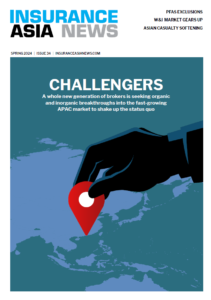SIRC: Capacity woes and rising rates dominate Asia renewals
November 4 2022 by Mithun Varkey
This week the Singapore International Reinsurance Conference (SIRC) returned as an in-person event after a three-year hiatus. The four-day event in Singapore’s iconic Marina Bay Sands brought together industry leaders from Asia Pacific and around the world to discuss renewals and the prospects of the (re)insurance sector as carriers face up to one of the toughest markets in more than a decade.
The premier Asian reinsurance conference saw reinsurers, brokers, insurers and service providers huddle to continue January renewal discussions and set the agenda for the year ahead.
There was much joy in rekindling old associations after more than a couple of years of online interactions, however, there was much anxiety and disquiet around the tough renewals discussions that lay in the months ahead.
Capacity: One of the main themes that dominated discussion at the conference – both in business meetings and in conversations along the corridors – was capacity constraint.
There was much handwringing over the lack of sufficient capacity to cover the reinsurance needs of the region, especially for property catastrophes.
It is a challenging environment for the (re)insurance sector as it is for other businesses given low economic growth, rampant inflation, fast-rising rates, and geopolitical tensions.
However, within (re)insurance, this is all underpinned by rising nat cat losses due to climate change as well as increasing claims costs due to inflation.
The days of free money that we saw in the last decade or so are gone, remarked one reinsurer. There is a fundamental imbalance between supply and demand and there will be gaps in cover.
The capacity strain will continue, and while there are attempts to raise fresh capital it is only likely to show results towards the second quarter of next year or later.
While there is little fresh capital being added to both reinsurance and retrocession capacity, carriers are also facing challenges internally on their assets side due to mark-to-market losses they have been registering on their investments.
ILS has been a challenging market and it would take a “brave fund manager” who would commit more money to catastrophe bonds in an era of climate change until they can get some consistent and predictable returns. Especially, in a higher-rate environment, when there are different options to make a return on capital.
Inflation: The rising price and its impact on costs and claims have been the other most common concern among the participants. While the price rise in the region has been relatively muted compared with Europe and the US, it continues to pose challenges to both insurers and reinsurers.
Inflation, which impacts the industry at several levels, is a challenge that is hard to ‘to put back in the bottle’ as Swiss Re Institute’s Asia chief economist John Zhu noted during a panel discussion on November 1.
Rachel Turk, group head of strategy, Beazley said, “It is hard to unbundle P&C premiums increase from inflationary pressures”.
The key is for insurers to be able to accelerate prices to reflect the rise in costs. However, for the industry, there is a lag between recognition of inflation and being able to price it in. Especially, on the long tail classes, delays can happen over many years.
Pricing: Through all these, pricing has been at the heart of the negotiations. There is certainly hardening and that is the only way for reinsurers to keep up with the challenging environment.
P&C prices have to increase to match claims costs and improve loss reserves.
Also, wages, suppliers, travel and entertainment costs are all set to go up. And the CPI index doesn’t include steel and lumber which are driving up property claims, Turk noted.
Reinsurers have had about five years of poor results and there is an inability across the sector to cover the cost of its own capital and it has to change. It is perfectly fair for reinsurers to be able to ask for a rate that gives them the ability to make a return on their cost of capital, noted a global insurer.
It isn’t, however, enough that reinsurers raise rates, but it should be reflected across the value chain, said an Asia-based senior executive at a reinsurer. Reinsurers will need to see that cedents are passing on the rate hikes to the insureds and get granular data on how carriers are managing inflation and how the prices respond, otherwise insurers will get “appropriately punished”.
Structuring: While prices will go up, insurers will have to do more in terms of structuring their reinsurance programmes. Reinsurers will expect cedents to agree to higher retentions.
Swiss Re Asia managing director Victor Kuk told InsuranceAsia News, “one thing is to increase the deductible at the insurance level, which means the insurance company will retain more exposure. Then reinsurers will come in at the more-high level of exposures.”
There is going to be pressure to push up the attachment points up and away from some of the first loss areas. There will be pressure to raise the return periods to something more realistic as insurers have been buying protection at way too low periods and it would be appropriate for reinsurers to seek that.
Non-modelled perils: The increasing severity and frequency of catastrophe events driven by climate change have been a source of concern for players in the region. However, most losses have been from what has been called secondary perils such as floods and bushfires.
The consensus across modellers, insurers, brokers and reinsurers has been that there is nothing secondary about such perils and they are perils. Brokers also argue that they are not so much non-modelled anymore because a lot of it is now modelled and past experiences have shown that the models have strong predictive value.
Floods and bushfires have been causing significant losses in the past several months across the region, notably in Australia earlier this year, Malaysia and China last year, and Korea, India, Pakistan have all faced massive floods.
Modellers point out that climate change signals are stronger with the secondary perils than what is seen with other perils such as tropical cyclones.
However, most agree that climate change is not necessarily the primary leader for nat cat losses but exposure due to rising urbanisation, the concentration of population as well as poor infrastructure are the biggest driver of losses for the industry, especially so for the emerging markets in the region.
While these were the overriding themes of discussion, there were ongoing discussions about leveraging non-cat lines. On the casualty liability side, for example, while there is a need to recognise the rising costs and their impact on claims, insurers have had significantly more success in passing on the rates to their customers.
Specialty lines have also seen more interest with the general hardening of rates and appetite among reinsurers. Cyber, though, has the house divided. While many feel there is an opportunity to make money and there are attempts afoot to bring in more capacity, others feel that the risks are too varied and unpredictable for it to be sustainable in the short term.
Amid the gloom and doom, there are however optimists who feel that the temporary dislocation offers plenty of opportunities to grow be it through M&A or through prudent asset management as rates normalise.
While the going is tough for now, surely it is an opportunity for the tough to get going.
-
Allianz Commercial’s Sandric targets double-digit growth in Asia but cautions on market softening
- April 19
The carrier aims to be a leader in the region's competitive commercial risks space and expand its alternative risk transfer solutions and multinational program offerings, the Asia chief executive told InsuranceAsia News.
-
Hong Kong’s national security law eases US$100m political violence concerns
- April 18
The new law has lowered concerns of exposure to another event akin to the 2019 protest, still (re)insurers haven't relaxed underwriting considerations.
-
Insurers wrestle with rising claims as lithium battery use widens
- April 17
The industry needed to define its positions on whether the battery fire is an operational risk for users, or a product liability risk, especially in the case of thermal runaway.
-
IRDAI’s onshoring push may squeeze out cross-border reinsurers
- April 16
The Indian regulator’s plan to introduce collateral will raise costs, increase compliance and administrative burdens.

